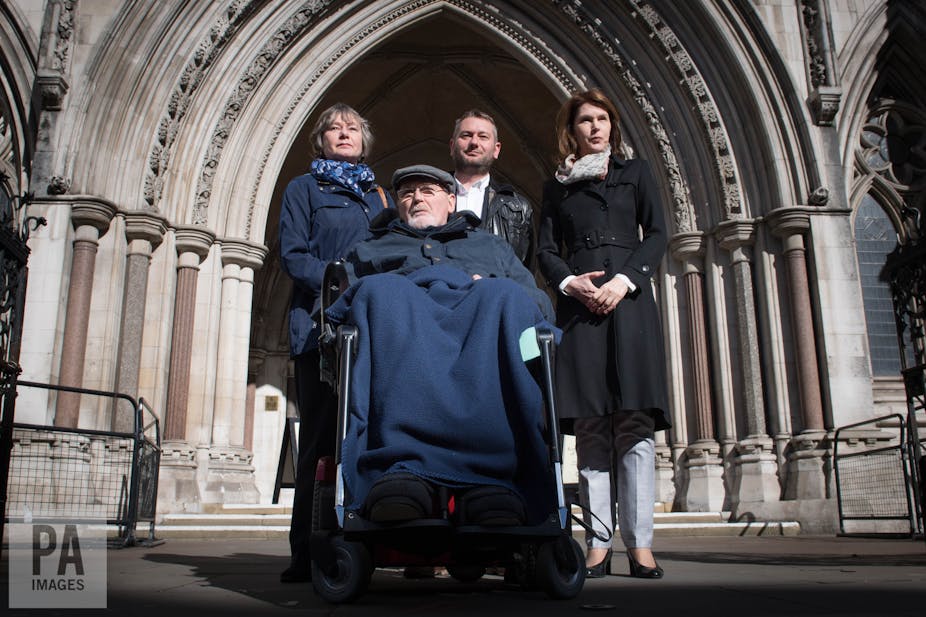The High Court has rejected a judicial review challenging the current law which prohibits assisted dying in the UK. Noel Conway, a 67-year-old retired lecturer who was diagnosed with Motor Neurone Disease in 2014, was fighting for the right to have medical assistance to bring about his death. Commenting after the judgement on October 5, his solicitor indicated that permission will now be sought to take the case to the appeal courts.
Campaigners are often quick to highlight the strength of public support in favour of assisted dying, arguing that the current law is undemocratic. But there are reasons to question the results of polls on this sensitive and emotional issue.
There have been numerous surveys and opinion polls on public attitudes towards assisted dying in recent years. The British Social Attitudes (BSA) Survey, which has asked this question sequentially since the 1980s, has shown slowly increasing public support. Asked: “Suppose a person has a painful incurable disease. Do you think that doctors should be allowed by law to end the patient’s life, if the patient requests it?” in 1984, 75% of people surveyed agreed. By 1989, 79% of people agreed with the statement, and in 1994 it had gone up to 82%.
Detail of the question matters
But not surprisingly, the acceptability of assisted dying varies according to the precise context. The 2005 BSA survey asked in more depth about attitudes towards assisted dying and end of life care. While 80% of respondents agreed with the original question, support fell to 45% for assisted dying for illnesses that were incurable and painful but not terminal.
A 2010 ComRes-BBC survey also found that the incurable nature of illness was critical. In this survey, while 74% of respondents supported assisted suicide if an illness was terminal, this fell to 45% if it was not.

It may not be surprising that support varies considerably according to the nature of the condition described, but it is important. First, because the neat tick boxes on polls belie the messy reality of determining prognosis for an individual patient. Second, because of the potential for drift in who might be eligible once assisted dying is legalised. This has happened in countries such as Belgium which became the first country to authorise euthanasia for children in 2014, and more recently in Canada where within months of the 2016 legalisation of medical assistance in dying, the possibility of extending the law to those with purely psychological suffering was announced.
It’s not just diagnosis or even prognosis that influences opinion. In the US, Gallup surveys carried out since the 1990s have shown that support for assisted dying hinges on the precise terminology used to describe it. In its 2013 poll, 70% of respondents supported “end the patient’s life by some painless means” whereas only 51% supported “assisting the patient to commit suicide”. This gap shrank considerably in 2015 – possibly as a result of the Brittany Maynard case. Maynard, a high-profile advocate of assisted dying who had terminal cancer, moved from California to Oregon to take advantage of the Oregon Death with Dignity law in 2014.
Even so, campaigning organisations for assisted dying tend to avoid the word “suicide”. Language is emotive, but if we want to truly gauge public opinion, we need to understand this issue, not gloss over it.
Information changes minds
Support for assisted dying is crucially known to drop-off simply when key information is provided. Back in the UK, a ComRes/CARE poll in 2014 showed 73% of people surveyed agreed with legalisation of a bill which enables: “Mentally competent adults in the UK who are terminally ill, and who have declared a clear and settled intention to end their own life, to be provided with assistance to commit suicide by self-administering lethal drugs.” But 42% of these same people subsequently changed their mind when some of the empirical arguments against assisted dying were highlighted to them – such as the risk of people feeling pressured to end their lives so as not to be a burden on loved ones.
This is not just a theoretical phenomenon. In 2012, a question over legalising assisted dying was put on the ballot paper in Massachusetts, one of the most liberal US states. Support for legalisation fell in the weeks prior to vote, as arguments against legalisation were aired, and complexities became apparent. In the end, the Massachusetts proposition was defeated by 51% to 49%. Public opinion polls, in the absence of public debate, may gather responses that are reflexive rather than informed.
Polls are powerful tools for democratic change. While opinion polls do show the majority of people support legalisation of assisted dying, the same polls also show that the issue is far from clear. It is murky, and depends on the responder’s awareness of the complexities of assisted dying, the context of the question asked, and its precise language. If we can conclude anything from these polls, it is not the proportion of people who do or don’t support legislation, but how easily people can change their views.

